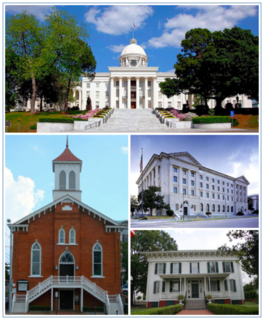
Montgomery is the capital city of the U.S. state of Alabama and the county seat of Montgomery County. Named for Richard Montgomery, it stands beside the Alabama River, on the coastal Plain of the Gulf of Mexico. In the 2010 Census, Montgomery's population was 205,764. According to the US estimated census of 2019, it is the third most populous city in Alabama, after Birmingham and Huntsville, and is the 118th most populous in the United States. The Montgomery Metropolitan Statistical Area's population in 2010 was estimated at 374,536; it is the fourth largest in the state and 136th among United States metropolitan areas.

This is a list of the National Register of Historic Places listings in Limestone County, Alabama.

This is a list of the National Register of Historic Places listings in Montgomery County, Alabama.

The City of St. Jude is a 36-acre (15 ha) campus in Montgomery, Alabama, hosting a high school, hospital, and Catholic church, and was founded in 1934 by Fr Harold Purcell with the aim of bringing "light, hope and dignity to the poor."
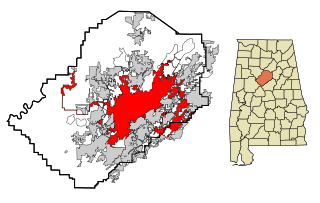
This is a list of the National Register of Historic Places listings in Birmingham, Alabama.

The Frank M. Johnson Jr. Federal Building and United States Courthouse is a United States federal building in Montgomery, Alabama, completed in 1933 and primarily used as a courthouse of the United States District Court for the Middle District of Alabama. The building is also known as United States Post Office and Courthouse—Montgomery and listed under that name on the National Register of Historic Places. In 1992, it was renamed by the United States Congress in honor of Frank Minis Johnson, who had served as both a district court judge and a court of appeals judge. It was designated a National Historic Landmark in 2015.
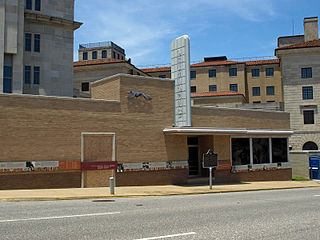
The Freedom Rides Museum is located at 210 South Court Street in Montgomery, Alabama, in the building which was until 1995 the Montgomery Greyhound Bus Station. It was the site of a violent attack on participants in the 1961 Freedom Ride during the Civil Rights Movement. The May 1961 assaults, carried out by a mob of white protesters who confronted the civil rights activists, "shocked the nation and led the Kennedy Administration to side with civil rights protesters for the first time."

The Dr. C.A. Thigpen House is a historic mansion in Montgomery, Alabama, U.S.. It was built for Dr. Charles A. Thigpen, a physician, circa 1898. It was designed in the classical style by architect Frank Lockwood. It has been listed on the National Register of Historic Places since 13 December 1977.
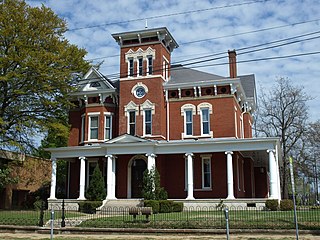
The Tyson–Maner House is a historic mansion in Montgomery, Alabama, U.S.. It was built in 1890 for Archibald Pitt Tyson, a former farmer turned real estate developer. It remained in the family until 1930, as it was inherited by his wife Ellen Nicholson Arrington in 1918 and later by their children. By the 1970s, it belonged to Carl Herbert Lancaster, an architect. It has been listed on the National Register of Historic Places since May 10, 1979.

The Winter Building is a historic building in Montgomery, Alabama, U.S..

The Tulane Building is a historic building in Montgomery, Alabama, U.S.. It was built from 1904 to 1908 by Victor Tulane, a black businessman who was a trustee of the Tuskegee Institute. Booker T. Washington visited the Tulane in the building in 1908. It has been listed on the National Register of Historic Places since March 21, 1979.

The Steiner–Lobman and Teague Hardware Buildings are historic buildings in Montgomery, Alabama, U.S.. They were built by businessmen Louis Steiner and Nathan Lobman circa 1891 for their dry goods store. By 1895, the Southern building was sold to William Martin Teague, the owner of the Teague Hardware Company. The buildings remained in the respective families as late as the 1970s. They have been listed on the National Register of Historic Places since January 31, 1979.

The Rice-Semple-Haardt House is a historic house in Montgomery, Alabama, U.S..

The Pepperman House is a historic house located at 17 Mildred Street in Montgomery, Alabama.
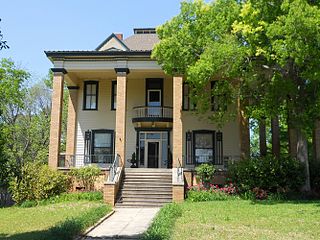
The Floyd-Newsome House is a historic house in Phenix City, Alabama, U.S.. It was built in 1898 as a cottage for Dr Floyd, a physician and judge who was also the mayor of Phenix City. By 1908, a second story was built, and it was redesigned in the classical architectural style. It remained in the Floyd family until 1958, when it was purchased by the Aldridge family. It has been listed on the National Register of Historic Places since November 3, 1983.

The Brooks-Hughes House is a historic house in Phenix City, Alabama, U.S.. It was built from 1897 to 1904 as a cottage for W. T. Hall. It has been listed on the National Register of Historic Places since November 3, 1983.

The McNab Bank Building is a historic building in Eufaula, Alabama, U.S.. It was built in the 1850s for John McNab, a Scottish-born banker. It has been listed on the National Register of Historic Places since June 24, 1971.

The Morgan-Curtis House is a historic house in Phenix City, Alabama, U.S.. It was built in 1914 for Dr. David Elias Morgan, a Welsh-born physician. It has been listed on the National Register of Historic Places since November 3, 1983.
Frederick Ausfeld was a US-based, German-born architect. He designed buildings in Montgomery, Alabama, some of which are listed on the National Register of Historic Places.




















